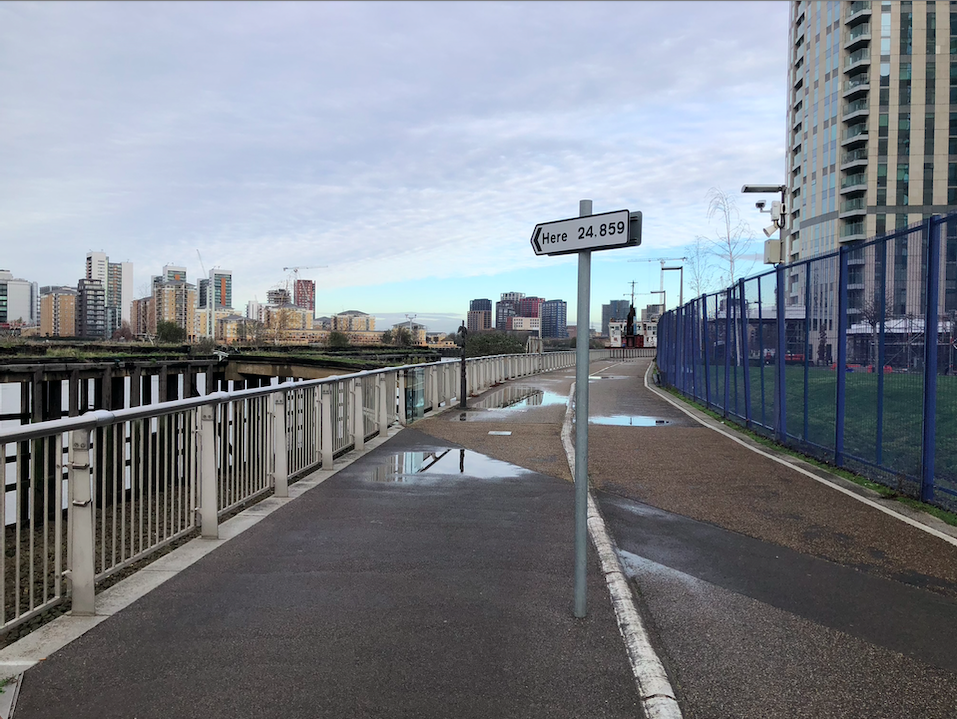


As Megan Piper says in her introduction to The Line, no two walks will be the same. The experience will depend on the weather, the time of day or the route you take. It may also be defined by how you choose to engage; you might choose the short audio clip where the artist offers a brief introduction to their work, or take a “deep dive” and listen to the longform audio discussion. Alternatively, you might decide to take some moments for yourself and walk The Line listening to one of three specially-commissioned mindfulness guides. Or you might just have time for a quick glance at a few of the artworks before you go about the rest of your day.
The Line was co-founded by Megan Piper and the late regeneration expert Clive Dutton OBE (1953-2015). Their ambition was to connect two of the most important regeneration sites – Stratford and Greenwich Peninsula – with an outdoor exhibition programme that encourages locals, Londoners and visitors to engage with modern and contemporary art, while discovering this lesser-known part of the city, its wildlife and heritage.
The Line connects three boroughs (Newham, Tower Hamlets and Greenwich) and, following the Greenwich Meridian, runs between the Queen Elizabeth Olympic Park and The O2. It features an evolving programme of art installations (loans and commissioned works), projects and events, creating a landscape where everyone can explore art, nature and heritage for free.
The walk can be experienced from any starting point and as a whole walk or in sections. I arrive in North Greenwich planning to do the walk in one go.
Starting from North Greenwich station, the first piece I come across is A Bullet from a Shooting Star by Alex Chinneck. On any other day and without the guide, I might simply have walked straight past it. However, as I pause to take a closer look, I sense the uncanniness around its location, its angle, its structure. I listen to Alex Chinneck describe a 35-meter electricity pylon which appears to have crash-landed as “Structurally complex, sculpturally simple”.
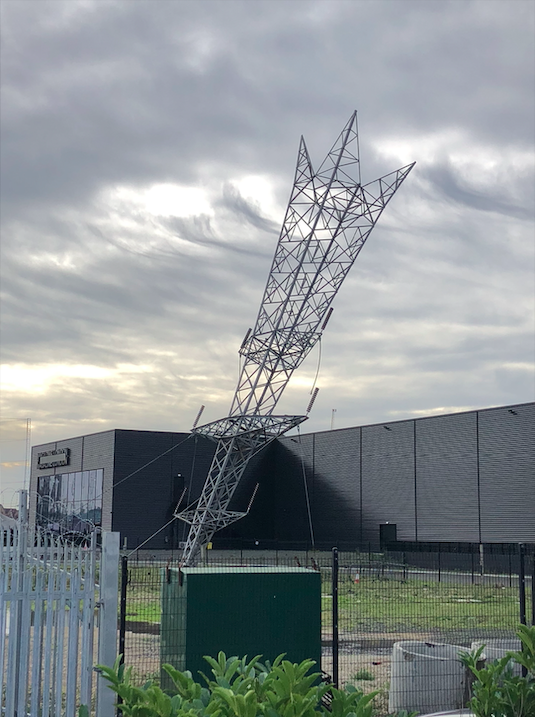
Continuing along the route, Here by Thomson & Craighead is planted in the centre of the walkway. You can usually always count on a traffic sign being where you need it to be, conveniently placed without attracting too much attention, yet, this sign is physically demanding me to take notice. Wondering where the ‘here” is that it’s pointing to, I listen as the guide tells me that the sign is on the invisible Greenwich Meridian, pointing north, with the distance representing the circumference of the earth and thus the distance of the sign from itself. Listening to the artists discuss the work and watching people jog past it oblivious on their afternoon runs, I’m glad I have taken the time to pause and listen in this moment. As Thompson said, with traffic signs, we often “read them but we don’t see them”.

All the artworks I encounter on The Line, are grounded in a sense of place with links to the local area and its history. Richard Wilson’s A Slice of Reality, is 1/8th slice of an ocean-going sand dredger. Once more, it is a piece that doesn’t initially stand out, but taking a second look, it begins to reveal itself in its oddness. It is too perfectly cut into to be a rusted piece of a ship and it doesn’t quite make sense for it to be so upright at such a low tide. Wilson describes the sculpture as a ‘sound bite’ of the rich maritime history of Greenwich, as well as a reflection of how the invisible Meridian slices through Greenwich.
Nearing the end of the first part of the walk which takes me around the O2 Arena, Liberty Grip by Gary Hume is the first piece I encounter that stands out as being “sculptural” in the traditional sense. Hume, who is mainly a painter, modelled the sculpture on parts of a store mannequin. The playfulness of the sculpture with its pop of pink is balanced by morbidity as Hume reveals in the guide that the pink signifies flesh.
By the North Greenwich pier, Anthony Gormley’s Quantum Cloud gets ever more monumental the closer I approach. Representing a bundle of energy, it is a fascinating piece to observe as I walk towards it. Although static, it seems to reflect my movement – it’s fluid and I want to see it from all angles as the experience and scale is different depending on which direction you are coming from. Listening to the guide, I am fascinated to discover that Gormley says the piece is unfinished.
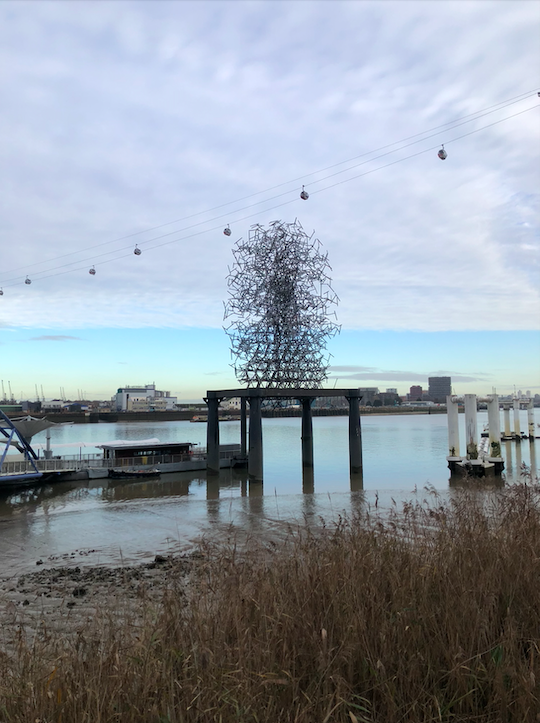
One of the most engaging parts of the walk doesn’t require any actual walking, but instead involves crossing the River Thames on the Emirates Air Line while listening to Larry Achiampong’s site specific piece, Sanko-time, 90 metres above the ground. Suspended high above this central artery that links London to the sea, immersed in the mix of voices, field recordings and music, I find my fear of heights is alleviated by this physical and audio journey. I am fascinated to discover how the Meridian line connects the Royal Docks in Greenwich to Accra in Ghana, the sound piece is almost a physical embodiment of this historical connection and a unique way to reflect on the history and impact of the British Empire and colonialism.
Disembarking from the Emirates Air Line, in the river by the dock I see Bird boy (without a tail) by Laura Ford. The heart-breaking vulnerability of the boy in a bird costume is made all the more poignant by the streaks of bird excrement that cover him.
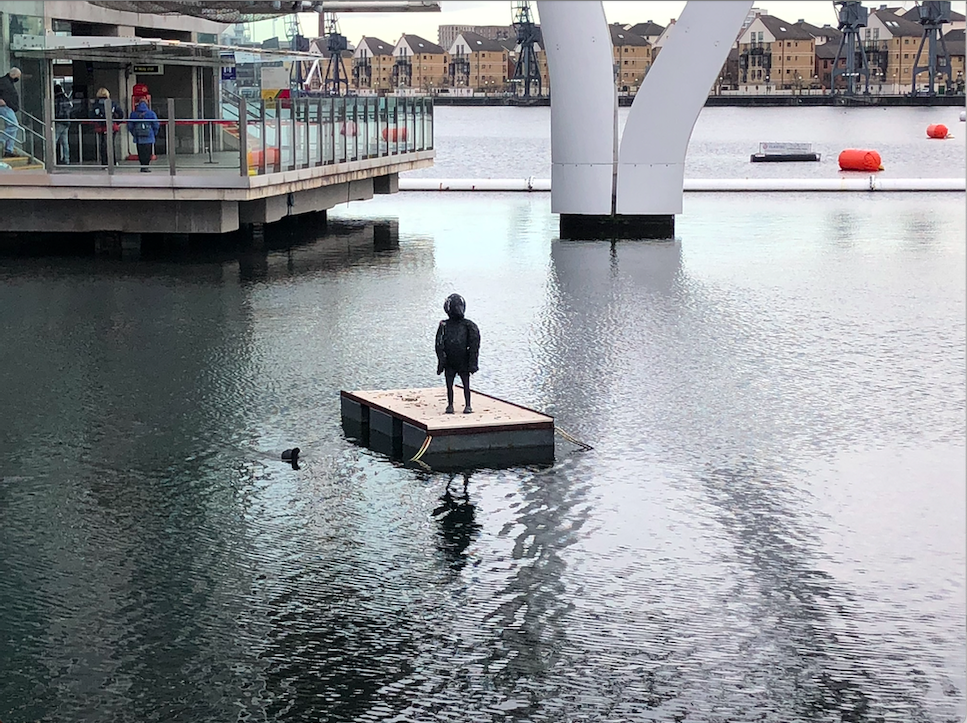
For the next part of the walk, from the Royal Docks to Cody Dock, I would advise coming prepared with an idea of the route because, with all the construction work currently taking place, it’s a bit more difficult to follow (though that might also be because I’m unfamiliar with the area). To get to Joanna Rajkowska’s The Hatchling, I had to pass through a very industrial area and a long stretch between the artworks.
Here amongst all the building works, is the moment to listen to the mindfulness walk on the app, a great way to switch off and disconnect from the hustle and bustle of the building works. It feels like an odd place to find artwork, but when I finally reach Cody Dock, I feel a sense of relief to enter this pocket of community and creativity by the river.
The Hatchling is a giant, textured egg, blue and rust in colour, and lies on the ground on a patch of grass just by the river. The audio guide encourages me to approach and touch it, and pressing my ear to the egg’s surface, I hear the sound of chicks hatching. It is a moment of intimacy, where I feel connected to the beginning of life and for a moment, reality feels suspended as I picture this giant baby bird about to hatch.
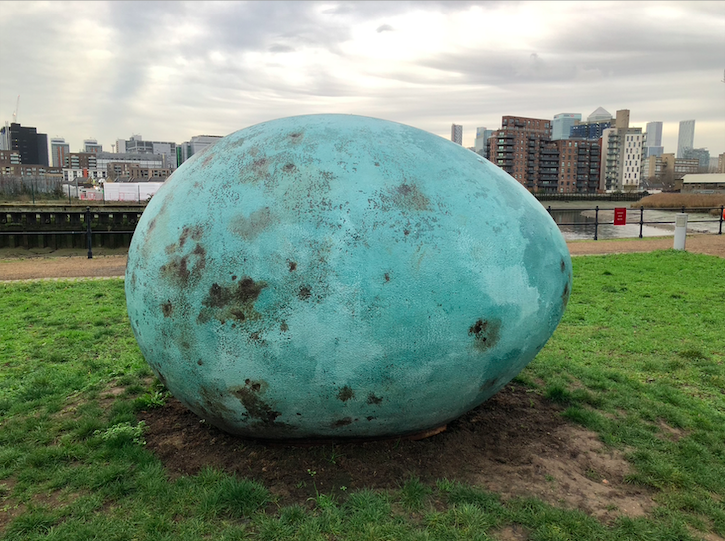
Continuing along the route, Abigail Fallis’ DNA DL90 appears in the distance at a curve in the river walk. The helix formation becomes clearer as I get closer, and while the bright colours make it seem playful, at the same time the vision of shopping carts piled high one on top of the other is one of excess and it is sobering to reflect on how consumption now truly feels embedded in our existence.
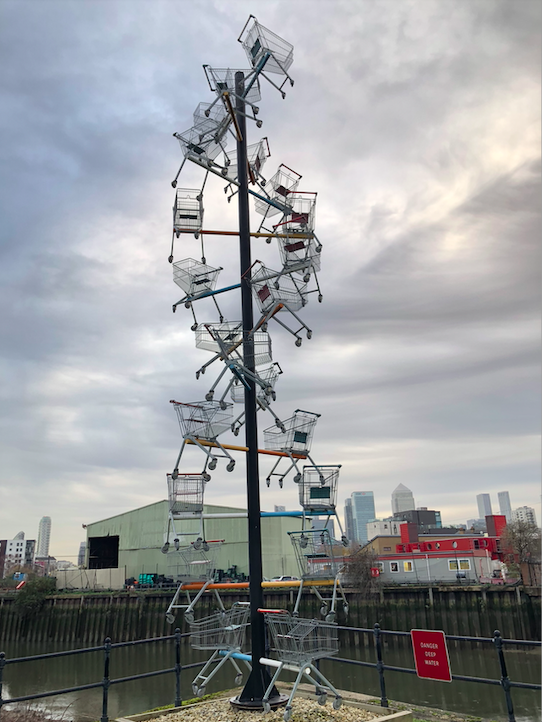
After manoeuvring my way around a blocked road, I make it onto the Three Mills Green island and Thomas J Price’s Reaching Out. The bronze sculpture is of a nine-foot-tall black woman, standing casually as she checks her phone. During a time in which Black Lives Matter protests have sparked debate around public art and the lack of representation, Reaching Out stands out as one of very few statues of black women in the UK, with even fewer being the works of black artists. Rising directly from ground level with no plinth, she is both tall and grand and at the same time understated in her dress and her stance.
Standing facing this nine-foot-sculpture of a black woman looking at her phone, my attention is caught by her trainers, so similar to my own. It’s really something to be there, both with our feet planted on the grass, phones in hand. She feels like a reflection not just of reality, but of myself.
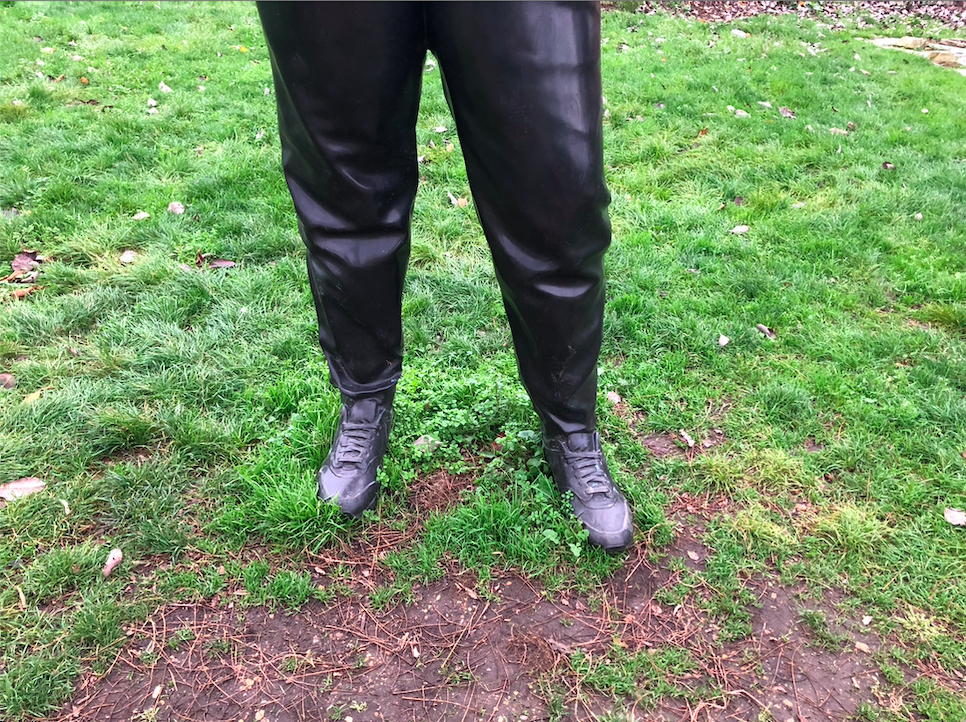
Having recently moved to London from a much smaller city, walking The Line was a valuable reminder that a slower pace enables one to pay attention to the understated and uncanny, and to notice things that you might otherwise walk past without seeing. For me, Reaching Out, reminded me that while we create connections across the globe through our mobile phones, by looking at them constantly, they can also make you lose a sense of what’s physically around you.
My last stop walking The Line was ArcelorMittal Orbit by Anish Kapoor. At 115 metres tall it is the UK’s tallest sculpture, created as a permanent tower for the Olympic Park in 2012. According to the guide, there is no singular view from any one perspective of this sculpture. Although bright red and oddly-shaped, it is both hard to miss and yet blends into the backdrop of construction, mirroring the cranes around it. The work also incorporates The Slide by Carsten Holler, which was created in 2016 at the invitation of Anish Kapoor. At 178 meters long, the slide is also record breaking as world’s tallest and longest tunnel slide and according to Holler “it’s virtually impossible to go down a slide without smiling”. It’s too late by the time I arrive though.
In total, the walk takes me around three hours. The Line is a great way to lose oneself for an afternoon and engage with art while learning about the history of the area. After a very stationary year, the long walk felt good and was a great opportunity to re-connect with the present moment while momentarily distracting myself from my day-to-day worries.
Download the Bloomberg Connects app here
*the walk took place in December before the current lockdown restrictions.